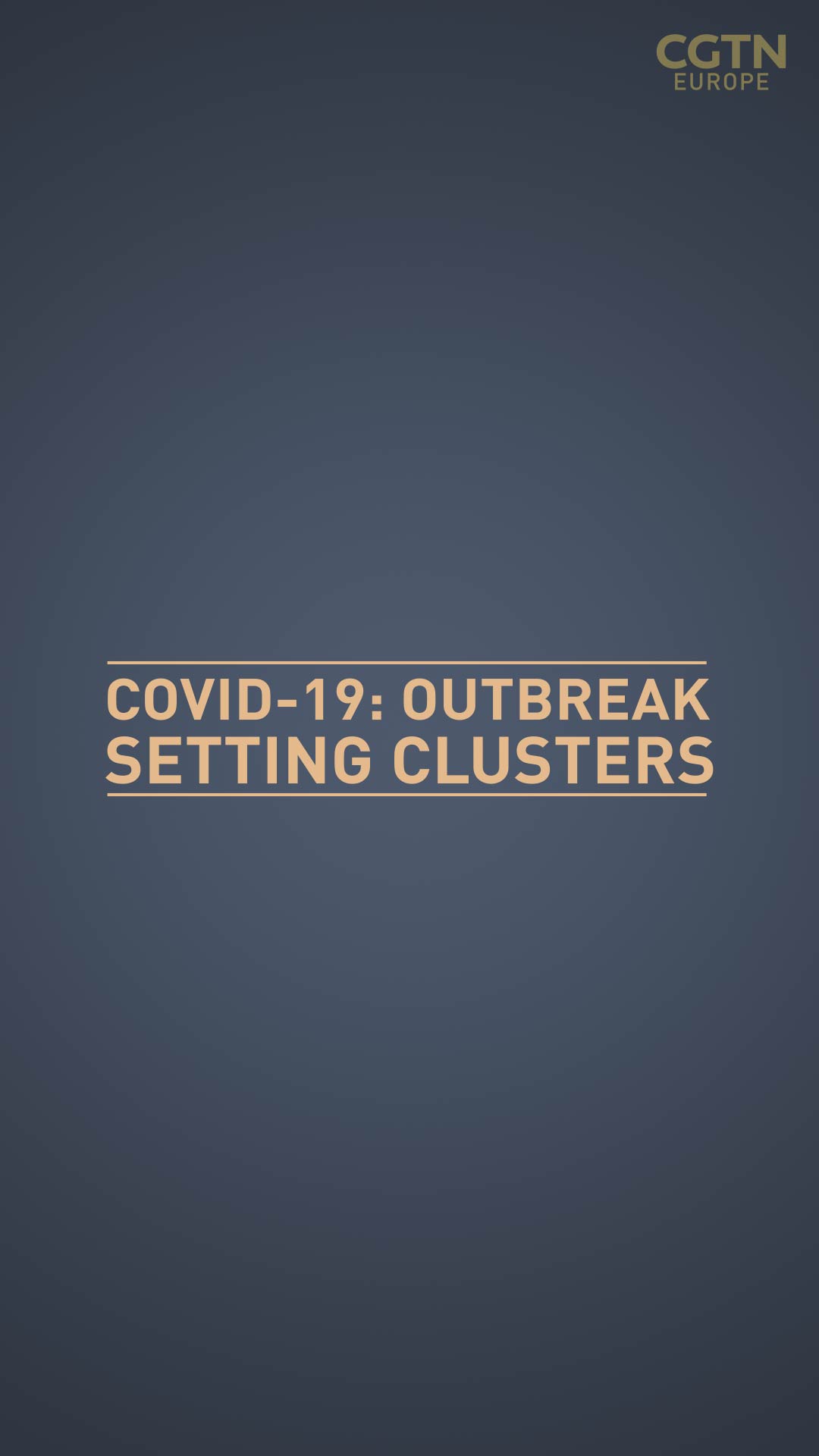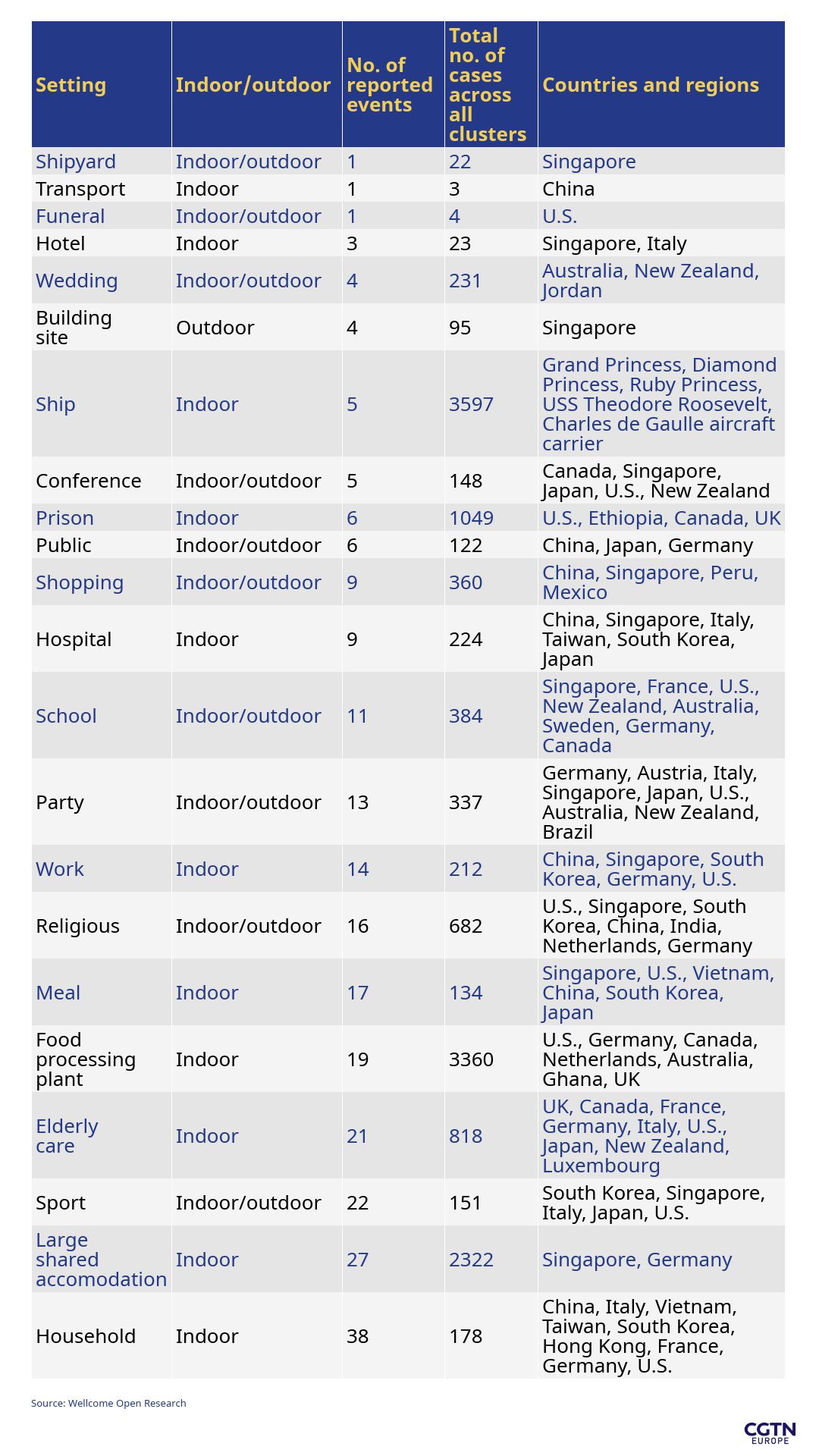01:23

Households, large shared accommodation, ships and food processing plants are the places where the highest number of coronavirus outbreaks and the highest number of cases per outbreak, have occurred, according to ongoing research.
Since the start of the COVID-19 outbreak in December and its subsequent spread to global pandemic level, countries across the world have been scrambling to reduce and stop its public health impact.
Most governments implemented strict measures limiting the movement of people both within their countries, with localized lockdowns, as well as abroad, by closing borders and halting travel. But after several weeks, severe economic impacts and wider societal consequences have been felt in most countries due to these unprecedented measures.
Now, roughly four months after governments rolled out these measures, many are now lifting restrictions in the hope of furthering "exit strategies" that would return society and the economy to a semblance of normality. But opinions on these exit strategies and their efficacy are mixed, as some worry they may result in resurgence of cases, or a "second wave."
The Wellcome Trust's Open Research has
published a paper,
which the researchers involved say aims to inform these exit strategies by exploring the types of indoor and outdoor settings where transmission of the virus has been reported to occur and result in clusters of cases.
"Identifying potential settings that result in transmission clusters allows these to be kept under close surveillance and/or to remain closed as part of strategies that aim to avoid a resurgence in transmission following the lifting of lockdown measures," the paper's authors write.

Where did the clusters appear?
The Wellcome Open Research study, which collated and reviewed available literature and media reports, found many examples of COVID-19 clusters linked to a wide range of mostly indoor settings.
The report is continuously being updated, but the latest data provided present a total of 252 transmission events, classified into 22 setting types. The settings are categorized as: shipyard, transport, funeral, hotel, wedding, building site, ship, conference, prison, public, shopping, hospital, school, party, work, religious, meal, food processing plant, elderly care, sport, large shared accommodation and household.
"We defined a setting when several reports mentioned clusters linked to spaces with certain characteristics. For example, 'religious' includes churches and mosques, while 'public' here means public communal shared spaces such as markets or welfare centers. Where settings were a mixture of indoor and outdoor spaces, we used a mixed indoor/outdoor classification," the researchers explain.
According to the findings, the vast majority of the clusters reported were associated with indoor settings, or mixed indoor/outdoor settings (21/22). A building site was the only fully outdoor setting where clusters were also identified.
Although not everything is known about the exact transmission risks and patterns of COVID-19 in relation to the difference between indoor and outdoor settings, many scientists agree that due to the respiratory nature of the virus, it may be the case that transmission risks are higher in closed spaces where infected droplets could land on surfaces and be transfered.
According to the report, 13 clusters of virus transmission were reported in party settings, which include bars, clubs and small live music venues. /Alain Jocard/AFP
Where did the most cases per cluster take occur?
The study also found that the majority of clusters involved fewer than 100 cases each (222/252). These were all in the following settings: shipyard, transport, funeral, hotel, wedding, building site, conference, public, party, work, meal, sport, household. While there may have still been a large number of clusters reported in some of these settings, particularly household, sport, meal, work and party, it appeared that the total number of cases in all the clusters combined was lower than other settings.
The outliers, in this case the 30 clusters that had more than 100 cases in total, appeared in the following settings: Eight clusters were in food processing plants, six in large shared accommodation, four in prisons and on board ships, three in religious gatherings, two in elderly care, and one in hospital, school, and shopping.
Large shared accommodation and households were found to be the two settings with the highest number of reported outbreak clusters, 27 and 38 clusters respectively. But when it came to the total number of cases across all clusters, ships and food processing plants had the highest number of coronavirus cases, with 3,597 and 3,360 respectively.
The researchers explain that large shared accommodation, such as worker dormitories, "are similar to households in the sense that they are places where people live together and come in frequent close contact; however, the number of residents in dormitories is higher than in most other households. This probably contributes to the higher cluster sizes seen in this setting."
"Additionally, hygiene facilities can be limited in worker dormitories, which could also explain the higher transmission," they add.
As for the high number of cases in food processing plants, the researchers say it is a fairly unexpected setting type, but 19 clusters were identified in seven different countries including Germany, the Netherlands and the UK. Eight of these clusters had more than 100 cases, with the highest number of cases, 1,029, recorded at the Rheda-Wiedenbrück meat processing plant in Germany late last month.
The researchers say this high number could be explained by the cold atmosphere in the setting, which may facilitate the spread of the virus, or the close proximity of the workers and the shared welfare spaces, as well as workers speaking loudly to communicate over the noise of the machines, which could lead to an increased projection of viral particles.
"Another explanation is that we may not be seeing clusters from other manufacturing settings with similar working environments, as fewer have been in operation due to lockdown guidelines during the pandemic, whereas food production has continued," they note.
Determining particular places that are linked to clusters of cases could reveal settings that are responsible for amplifying the heterogeneity in transmission
- Quentin J. Leclerc, Naomi M. Fuller, Lisa E. Knight
While the researchers say these data could help glean more useful information on where the evidence has shown the virus is more likely to spread, they also say that, as with other new research into COVID-19, there are limitations.
"Many of the more detailed studies originated from the early outbreak in China, especially those providing household information. The settings we identified here therefore might not be representative of settings from a global perspective," the paper says.
"Bias is present when relying on media coverage – a cluster is more likely to be reported if controversial or if there is an interesting social narrative. This is then compounded by the method search engines use to provide results where priority is given to high-traffic stories. Overall, this can lead to some settings being overly represented in our database, which is why the numbers of clusters per settings should be compared cautiously," the paper adds.
But understanding in which types of social settings the virus is more likely to be transmitted, could be a vital first step in the successful removal of lockdown restrictions while avoiding a resurgence in COVID-19 transmission.
"Determining particular places that are linked to clusters of cases could reveal settings that are responsible for amplifying the heterogeneity in transmission that has been reported: potentially 80 percent of transmission is being caused by only 10 percent of infected individuals," the researchers say.
 简体中文
简体中文

